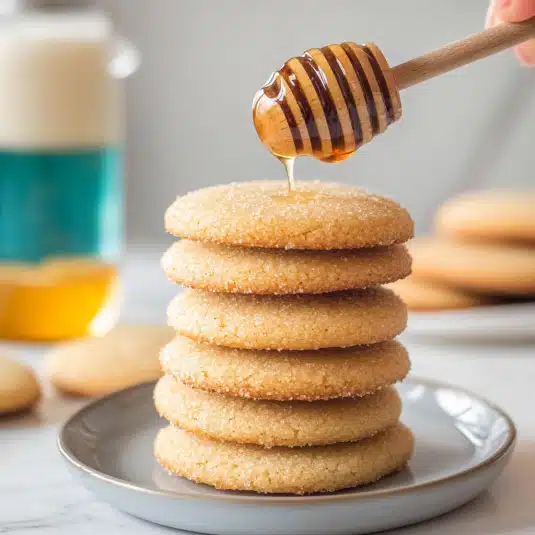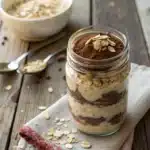Honey cookies are more than just a sweet treat—they’re a timeless dessert loved for their golden color, rich flavor, and irresistibly soft, chewy texture. Whether you’re craving a healthier alternative to sugar-laden snacks or just love the depth that honey adds to baking, these cookies strike the perfect balance between indulgence and wholesome goodness.

In this ultimate guide to honey cookies, we’ll explore everything from the science behind how honey affects texture and moisture, to selecting the best variety for flavor, and even diving into must-try recipes and baking techniques. You’ll also learn why honey is not only a natural sweetener but a functional ingredient that enhances softness, improves shelf life, and creates beautifully caramelized edges.
Table of Contents
Why Honey Cookies Are a Timeless Favorite
What Makes Honey Cookies Unique?
One bite of honey cookies and you’ll understand why they’ve been a household staple for generations. The natural sweetness of honey isn’t just about flavor—it actually transforms the cookie’s texture. Unlike granulated sugar, honey is a humectant, meaning it draws moisture from the air, keeping cookies softer for longer.
Another bonus? The flavor profile. Depending on the type of honey used—wildflower, clover, orange blossom—your cookies can take on subtle floral, fruity, or earthy notes. This gives each batch of honey cookies its own unique twist, making them stand out from standard sugar cookies.
Honey also helps your cookies brown faster and more evenly, giving them a gorgeous golden finish and a light crisp edge that melts into a soft, chewy center.
Print
Honey Cookies
- Total Time: 25 minutes
- Yield: 18 cookies 1x
Description
Soft, chewy, and naturally sweet, these golden honey cookies bring out the comforting flavors of pure honey in every bite. Perfect for tea time, snack boxes, or wholesome treats.
Ingredients
- ½ cup unsalted butter (softened)
- ¾ cup raw honey
- 1 large egg
- 1 tsp vanilla extract
- 1 ¾ cups all-purpose flour
- ½ tsp baking soda
- ½ tsp salt
- Optional: 1 tsp cinnamon, orange zest, or ground ginger
Instructions
- Cream butter and honey until smooth.
- Add egg and vanilla; mix until combined.
- In another bowl, whisk together flour, baking soda, and salt.
- Gradually add dry mix to wet ingredients, stirring until dough forms.
- Chill dough for 30–45 minutes.
- Roll into balls and place on a parchment-lined baking sheet.
- Bake at 325°F for 9–11 minutes or until edges are golden.
Notes
Use raw honey for deeper flavor. Do not overbake—cookies will firm up as they cool.
- Prep Time: 15 minutes
- Cook Time: 10 minutes
- Category: Dessert
- Method: Baking
- Cuisine: American
Nutrition
- Serving Size: 1 cookie
- Calories: 110
- Sugar: 7g
- Sodium: 80mg
- Fat: 5g
- Saturated Fat: 3g
- Unsaturated Fat: 2g
- Trans Fat: 0g
- Carbohydrates: 15g
- Fiber: 0g
- Protein: 1g
- Cholesterol: 15mg
A Brief History of Baking with Honey
Baking with honey isn’t a trend—it’s tradition. Long before white sugar was even an option, bakers across ancient civilizations relied on honey to sweeten their breads and cakes. Egyptians used it in ceremonial pastries, Greeks made honey-based sweets during festivals, and Europeans baked gingerbread-style honey cookies during holidays and celebrations.
Its natural preservation properties and rich taste made it a prized kitchen staple. Today, honey is making a comeback in modern baking as people shift toward more natural, unrefined ingredients. And honey cookies are leading that sweet revolution.
Don’t miss our honey-forward dessert idea—this indulgent honey bun cake blends nostalgia with natural sweetness.
The Role of Honey in Cookie Baking
How Honey Affects Texture and Moisture in Cookies
When baking honey cookies, texture is everything—and honey is the secret weapon that delivers that coveted chewy center and soft bite. Honey acts as a natural humectant, meaning it attracts and retains moisture. This unique characteristic helps cookies stay moist longer than those made with granulated sugar.
What sets honey apart from other sweeteners is its ability to add tenderness without making the cookie dough too loose. Even in small amounts, honey helps prevent your cookies from becoming dry or crumbly. It also gives the cookies a denser, more satisfying mouthfeel—ideal for those who love chewy, bakery-style cookies.
Plus, since honey contains natural sugars like fructose and glucose, it caramelizes faster, contributing to that gorgeous golden-brown finish and enhancing the flavor complexity.
Understanding the Natural Chemistry of Honey in Baking
The magic of honey cookies lies in the way honey reacts during baking. Honey contains roughly 17% water and naturally has a low pH, giving the dough a mild acidic boost. This small shift can activate baking soda, leading to more lift and a lighter texture in the final cookie.
Honey also contains enzymes and minerals that interact with other ingredients, deepening the cookie’s flavor over time. That’s why many honey-based cookie recipes taste even better the next day. Its hygroscopic nature also means honey cookies maintain their softness longer when stored properly.
Here’s a breakdown of how honey compares to sugar in baking applications:
| Property | Honey | White Sugar |
|---|---|---|
| Moisture Retention | High – keeps cookies soft | Low – cookies dry out faster |
| Sweetness | Sweeter (use less) | Baseline sweetness |
| Acidity (pH) | Low pH – activates baking soda | Neutral |
| Browning Effect | Strong – faster caramelization | Moderate |
| Shelf Life Extension | Longer – attracts moisture | Shorter |
Baking tip: Because honey is sweeter than sugar, use ¾ cup of honey to replace 1 cup of sugar in recipes, and reduce other liquid ingredients by ¼ cup to maintain dough consistency.
Check out this chewy cookie recipe made with cream cheese and chocolate chips for ideas on how to blend rich ingredients with natural sweeteners.
Choosing the Right Honey for Cookies

Raw vs Processed Honey – Which Is Better for Baking?
Not all honey is the same, and for baking honey cookies, your choice can greatly influence both the taste and the texture. Most commercial honeys are processed, meaning they’re filtered and pasteurized to improve shelf life and clarity. While convenient, this process often strips away natural enzymes and flavor depth.
Raw honey, by contrast, is neither filtered nor pasteurized. It retains natural antioxidants, pollens, and a more complex taste. When used in cookie dough, raw honey creates deeper, more aromatic notes and contributes slightly more acidity—enhancing the cookie’s structure and softness.
Here’s a quick comparison for your baking decisions:
| Type of Honey | Flavor Profile | Best For |
|---|---|---|
| Raw Honey | Bold, earthy, aromatic | Rustic or whole grain cookies |
| Clover Honey | Mild, sweet, floral | Classic soft honey cookies |
| Wildflower Honey | Fruity, herbal, complex | Gourmet or spiced variations |
| Orange Blossom | Citrusy, floral | Lemon-honey or citrus blends |
| Acacia Honey | Light, neutral sweetness | Delicate cookie recipes |
When buying honey for your homemade honey cookies, always check the label. Pure honey with minimal processing brings out the best in your dough.
Best Types of Honey for Different Cookie Flavors
The flavor of your honey cookies depends heavily on the variety of honey you choose. Want warm, cozy notes? Try wildflower or buckwheat honey. Craving a mild cookie that pairs well with tea? Go for clover or acacia honey.
Some flavor pairing suggestions:
- Wildflower Honey: Use with cinnamon, oats, and dried fruits for a rich, chewy cookie.
- Orange Blossom Honey: Perfect for lemon zest or white chocolate chip cookies.
- Buckwheat Honey: Best for gingerbread-style or molasses cookies with deep flavors.
- Clover Honey: Ideal for everyday recipes and kid-friendly soft cookies.
By understanding how honey’s floral source impacts taste, you can tailor your recipe to match the mood or season. For a citrus-honey flavor twist, don’t miss our tiramisu cookies variation available here.
Perfecting the Honey Cookie Dough

How to Balance Wet and Dry Ingredients with Honey
Using honey in place of sugar isn’t as simple as a one-to-one swap—it brings extra moisture to your dough, which can make or break your honey cookies if not managed properly. Since honey is a liquid sweetener, you’ll need to slightly reduce other wet ingredients to avoid overly sticky or spread-out cookies.
Here’s what you need to keep in mind:
- Reduce other liquids (like milk or egg whites) by ¼ cup for every 1 cup of honey used.
- Increase flour slightly (1–2 tablespoons) if your dough feels too soft.
- Refrigerate the dough for a minimum of 30 minutes to help minimize spreading.
Honey is also more acidic than sugar, which helps activate baking soda—great news for achieving that light, tender crumb. But be careful: overdoing honey can overpower your cookie flavor or make the dough too sticky to manage.
For a smoother mixing process:
- Use room-temperature butter or oil.
- Blend honey with fat first before adding dry ingredients.
- Once the flour is incorporated, mix gently to avoid creating a tough texture.
Substituting Sugar with Honey: The Golden Ratio
One of the most common questions in honey baking is: Can I use honey instead of sugar in cookies? Absolutely—but with a little finesse. Since honey is about 25–30% sweeter than sugar, you can use a smaller amount and adjust the rest of the recipe accordingly.
Here’s the golden honey substitution formula:
| If a Recipe Calls For | Use This Much Honey | Reduce Liquid By | Lower Oven Temp By |
|---|---|---|---|
| 1 cup sugar | ¾ cup honey | ¼ cup | 25°F (about 15°C) |
| ½ cup sugar | ⅓ cup honey | 2 tbsp | 25°F |
Why reduce oven temperature? Because honey browns more quickly than sugar. Lowering the heat prevents over-baking or burning before your cookies are fully set.
For cookie lovers trying to reduce processed sugar, this swap is a game changer. Plus, honey adds a depth of flavor sugar just can’t replicate.
Don’t miss our delicious twist on cookies using pantry staples—these cranberry pistachio shortbread cookies are a great experiment for adding honey into firmer doughs.
Master Techniques for Soft and Chewy Honey Cookies
The Secret to Keeping Cookies Soft for Days
The biggest perk of baking honey cookies? That heavenly softness that lingers for days. But how do you lock in that chewy texture after they’ve cooled? The secret lies in both the ingredients and your baking process.
Here’s how to make your honey cookies stay soft longer:
- Use brown sugar or a mix of sugars: Even if you’re replacing white sugar with honey, adding a small amount of brown sugar helps hold in moisture.
- Don’t overbake: This is crucial. Remove cookies from the oven just when the edges are lightly golden and the centers still look a bit underdone. They’ll finish setting as they cool.
- Let the cookies rest on the baking sheets for a few minutes before moving them to a wire rack to cool completely. This helps the cookies firm up just enough without drying out.
- Keep them in an airtight container with a slice of bread to maintain softness. The bread releases moisture slowly, which the cookies absorb—keeping them soft for days.
And if you really want to amp up the softness, add a tablespoon of cream cheese to your dough for a rich, velvety texture.
Want a rich and creamy base? Try our condensed milk cookies recipe right here—they use similar principles for long-lasting softness.
Tips to Avoid Overbaking and Achieve the Perfect Texture
Getting that perfect balance of crisp edges and a gooey center takes more than just good timing. Here are some professional tips to master the texture of your honey cookies:
- Use parchment paper to help the cookies bake evenly and prevent burning.
- Scoop uniform dough balls using a cookie scoop so all cookies bake consistently.
- Rotate the baking tray halfway through to prevent hot spots from overbaking some cookies.
- Chill the dough—especially with honey-based recipes. Chilling the dough not only limits spreading but also enhances and deepens the flavors.
Bonus Tip: If your cookies come out too thin or flat, increase the flour by 1–2 tablespoons and chill the dough for longer next time.
These techniques aren’t just tips—they’re game changers. With a few tweaks, you’ll get chewy, bakery-quality honey cookies that hold their texture and taste better with every bite.
Delicious Honey Cookie Recipes to Try
Classic Chewy Honey Cookies with a Crispy Edge
When it comes to crowd-pleasing cookies, nothing beats the classics. These chewy honey cookies feature a pillowy center, subtly crisp edges, and a luscious, golden richness throughout. Using a mix of honey and butter, this recipe delivers consistent results and that addictive melt-in-your-mouth texture.
Ingredients:
- ½ cup unsalted butter (softened)
- ¾ cup raw honey
- 1 large egg
- 1 tsp vanilla extract
- 1 ¾ cups all-purpose flour
- ½ tsp baking soda
- ½ tsp salt
- Optional: cinnamon, orange zest, or ground ginger
Instructions:
- Cream butter and honey until smooth.
- Add egg and vanilla; mix until combined.
- In another bowl, combine the flour, baking soda, and salt, whisking until evenly blended.
- Slowly add dry mix to wet, stirring until a dough forms.
- Chill for 30–45 minutes.
- Roll the dough into balls and arrange them on a parchment-lined baking sheet.
- Bake at 325°F for 9–11 minutes or until edges are golden.
These cookies are perfect for tea time, gifting, or batch baking. The flavor deepens overnight, making them ideal for make-ahead desserts.
Looking for more soft cookie ideas? Don’t miss our cream cheese chocolate chip cookies—they’re a perfect base for honey substitution experiments.
Whole Wheat Honey Cookies with Oats and Almonds
For a healthier spin, try these whole wheat honey cookies packed with fiber-rich oats, heart-healthy almonds, and naturally sweetened with raw honey. They’re chewy, satisfying, and a great snack for both adults and kids.
Ingredients:
- ½ cup coconut oil or unsalted butter
- ½ cup raw honey
- 1 egg
- 1 tsp vanilla extract
- ¾ cup whole wheat flour
- ½ cup rolled oats
- ½ tsp baking powder
- ¼ tsp cinnamon
- ¼ cup chopped almonds
Instructions:
- Combine oil and honey until smooth.
- Add egg and vanilla, mixing thoroughly.
- Mix in flour, oats, baking powder, and cinnamon.
- Fold in almonds.
- Drop spoonfuls onto a parchment-lined sheet.
- Bake at 325°F for 10–12 minutes.
These cookies are naturally sweet, slightly nutty, and loaded with texture. Perfect for lunch boxes or post-workout snacks.
Want more cookie inspo? Try our tiramisu-style twist on cookies here—it blends bold flavor with soft structure, and could easily incorporate a drizzle of honey.
Creative Flavor Variations for Honey Cookies
Cinnamon Honey Cookies, Lemon Zest Honey Bites, and More
One of the best things about honey cookies is how easily they adapt to different flavors. Whether you prefer warm spices or bright citrus notes, honey enhances the profile of every ingredient it touches. If you’re tired of plain cookies, it’s time to get creative with your mix-ins.
Here are some standout flavor variations to try:
- Cinnamon Honey Cookies: Add 1 tsp ground cinnamon and a pinch of nutmeg to the dough. Coat the dough balls in cinnamon sugar before baking for a delightful snickerdoodle-inspired touch.
- Lemon Zest Honey Cookies: Add the zest of one lemon and ½ tsp lemon juice for a bright, tangy contrast. Perfect for springtime.
- Ginger-Honey Chews: Mix in 1 tsp ground ginger and 2 tbsp chopped crystallized ginger for a spicy-sweet kick.
- Vanilla Almond Honey Cookies: Stir in ½ tsp almond extract and top with slivered almonds before baking for a soft, nutty bite.
- Chai-Spiced Honey Cookies: Combine cinnamon, ginger, cardamom, and clove for a warm, comforting flavor—ideal for cold months.
With honey as your base, these cookies come out soft, aromatic, and golden every time.
Want more cozy cookie ideas? Check out our comforting scone-style creations with honey-like richness right here.
Combining Honey with Nuts, Dried Fruits, or Chocolate
Flavor isn’t the only area where you can innovate. The texture of honey cookies also benefits from fun add-ins like chopped nuts, chewy dried fruit, and melty chocolate chunks. These additions boost nutritional value and make your cookies more satisfying.
Top combinations to try:
| Add-In Type | Pair It With | Why It Works |
|---|---|---|
| Chopped Walnuts | Cinnamon or ginger dough | Adds crunch and warmth |
| Dried Cranberries | Orange zest dough | Tart + sweet balance |
| Dark Chocolate Chunks | Sea salt finish | Sweet, bitter, and salty in one bite |
| Shredded Coconut | Almond or vanilla base | Adds chew and tropical flavor |
| Sunflower Seeds | Whole wheat or oat-based dough | Nutty flavor, allergy-friendly texture |
Keep your total mix-ins to around ½ to ¾ cup per batch to maintain structure.
Experimenting with honey opens the door to dozens of flavor paths. The secret is balance—allow the honey to stand out while still complementing your other ingredients.
Common Mistakes to Avoid When Baking with Honey
Why Your Honey Cookies Might Turn Out Dry or Too Flat
Even the best bakers hit a few bumps when experimenting with honey cookies. From dough that spreads too much to cookies that dry out overnight, most issues come down to ingredient balance and baking technique. Let’s break down what could go wrong—and how to fix it.
1. Dough spreads too much:
This often happens when there’s too much liquid from the honey and not enough flour to hold structure.
Fix it:
- Chill the dough for at least 30 minutes
- Increase flour slightly (by 1–2 tbsp)
- Avoid overmixing, which warms the dough and loosens it
2. Cookies are dry or crumbly:
Ironically, too much flour or overbaking can dry out a cookie, even when using a humectant like honey.
Fix it:
- Don’t bake past the golden edge stage
- Store in airtight containers with a slice of bread or a piece of apple
- Avoid excess flour by spooning and leveling—not scooping—your measurements
3. Burned bottoms or uneven baking:
Because honey caramelizes faster than sugar, cookies with honey brown more quickly—especially on the bottom.
Fix it:
- Lower oven temp by 25°F when swapping sugar for honey
- Use light-colored baking sheets
- Always use parchment paper or silicone baking mats
4. Bland or overly sweet flavor:
If you’re not using the right type of honey or you use too much of it, cookies can taste either too sugary or too one-note.
Fix it:
- Stick to ¾ cup honey per 1 cup of sugar
- Use flavor-enhancing ingredients like cinnamon, vanilla, citrus zest, or sea salt
- Choose high-quality raw honey for better depth
Discover more mistakes to avoid in cookie baking in our post about crispy vs chewy cookie techniques—and how ingredients like honey shift the balance. (Add internal link if available.)
How to Store Honey Cookies for Maximum Freshness
You’ve baked the perfect batch of honey cookies, now what? Proper storage ensures they stay soft, flavorful, and ready to serve.
Best practices for storage:
- Cool completely before storing to prevent condensation.
- Store in an airtight container, placing parchment paper between layers to keep cookies fresh and intact.
- Place a slice of soft sandwich bread in the container—the cookies will absorb its moisture to remain soft.
- Store at room temperature for up to 5–7 days.
Can you freeze honey cookies?
Absolutely. Freeze in layers, wrapping them tightly in plastic wrap before placing them in a freezer bag or airtight container. They’ll keep their texture for up to 2 months. Thaw at room temperature before serving.
Want a soft cookie that freezes beautifully? Try these bakery-style condensed milk cookies here—they follow a similar structure to honey-based bakes.
Health Benefits of Baking with Honey
Nutritional Advantages of Using Honey Instead of Sugar
Choosing honey over refined sugar isn’t just a flavor upgrade—it’s a nutritional one too. Baking honey cookies brings more than just sweetness—it adds depth, moisture, and a unique character to your dough. Honey contains small amounts of vitamins, minerals, antioxidants, and enzymes that refined sugar simply doesn’t offer.
Here’s why honey is considered the smarter sweetener:
- Lower glycemic index: Honey has a slightly lower GI than white sugar, which means it causes a slower rise in blood sugar.
- Natural antioxidants: Especially in raw or darker honeys, which help fight oxidative stress.
- Antibacterial properties: Raw honey includes enzymes that promote gut health and immunity.
- Fewer empty calories: While still calorie-dense, honey offers trace nutrients like potassium, zinc, and B vitamins.
By replacing white sugar with honey in your homemade cookies, you’re making a choice that supports long-term health goals—without sacrificing flavor or texture.
Why Honey Is a Better Option for Kids’ Treats
If you’re baking for kids, honey cookies offer a gentler sweetener that’s less processed and potentially easier on little bodies. Unlike high-fructose corn syrup or cane sugar, honey provides a balanced sweetness that doesn’t spike energy levels as quickly.
Other child-friendly advantages:
- Less hyperactivity: Some parents notice fewer sugar crashes after treats made with honey.
- Improved digestion: Honey’s enzymes can aid in digestion, especially for sensitive tummies.
- Fewer preservatives: When using raw or local honey, you skip the additives found in commercial sweeteners.
However, it’s important to note that honey should never be given to infants under one year old due to the risk of botulism.
Want a wholesome, naturally sweet dessert that’s kid-approved? Try our banana bundt cake with honey tones—it’s moist, flavorful, and a great lunchbox filler. (Insert internal link if applicable.)
FAQs
How does honey affect the texture of cookies?
Honey adds moisture to cookies, resulting in a softer and chewier texture. It’s a natural humectant, meaning it retains moisture from the air, helping cookies stay fresh longer. Honey also accelerates browning, creating that golden, bakery-style look.
What is the benefit of honey in baking?
Honey offers multiple benefits in baking: it sweetens naturally, adds depth of flavor, improves softness, and extends shelf life. It also contains trace nutrients and antioxidants not found in processed sugar, making it a smarter sweetener for health-conscious bakers.
What is the secret to keeping cookies soft?
To keep honey cookies soft, avoid overbaking, chill your dough before baking, and store cookies in an airtight container with a slice of bread. Using honey instead of sugar also helps retain moisture for days after baking.
Can honey be substituted for sugar in cookies?
Yes! You can substitute honey for sugar by using ¾ cup honey for every 1 cup of sugar. Also, reduce other liquids in the recipe by ¼ cup and lower the baking temperature by 25°F to prevent over-browning.
Conclusion: Why Honey Cookies Belong in Every Kitchen
Honey cookies bring together the best of both worlds—wholesome ingredients and indulgent flavor. Whether you’re going for a chewy classic or a healthy whole grain twist, baking with honey offers superior taste, better texture, and cleaner nutrition. With the right techniques, you can create golden, soft, and unforgettable cookies that stay fresh for days and delight everyone from picky eaters to gourmet foodies.
So the next time you’re reaching for the sugar jar, stop—and grab the honey instead.
Discover great ideas like our citrus-forward tiramisu cookie twist here and don’t miss our whipped honey butter recipe here, perfect for pairing with your fresh-baked honey cookies.
Fore more recipes follow me in Facebook, medium and Pinterest




